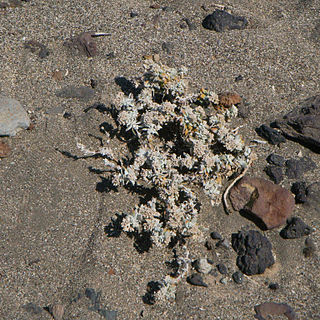
Herring are forage fish, mostly belonging to the family of Clupeidae.

The International Union for Conservation of Nature (IUCN) Red List of Threatened Species, also known as the IUCN Red List or Red Data Book, founded in 1964, is an inventory of the global conservation status and extinction risk of biological species. A series of Regional Red Lists, which assess the risk of extinction to species within a political management unit, are also produced by countries and organizations.

A booby is a seabird in the genus Sula, part of the family Sulidae. Boobies are closely related to the gannets (Morus), which were formerly included in Sula.

Wobbegong is the common name given to the 12 species of carpet sharks in the family Orectolobidae. They are found in shallow temperate and tropical waters of the western Pacific Ocean and eastern Indian Ocean, chiefly around Australia and Indonesia, although one species occurs as far north as Japan. The word wobbegong is believed to come from an Australian Aboriginal language, meaning "shaggy beard", referring to the growths around the mouth of the shark of the western Pacific.
The least gerbil is distributed mainly in South Sudan, southwestern Ethiopia, Kenya, and Tanzania.

Kemp's gerbil is a species of rodent. Mammal Species of the World considers G. kempi and G. gambianus to be synonyms, however the IUCN has assessed each taxon as were they different species.
Polycarpaea balfourii is a species of plant in the family Caryophyllaceae. It is endemic to Socotra in Yemen. Its natural habitats are subtropical or tropical dry shrubland and rocky areas.

Polycarpaea is a genus of plants in the family Caryophyllaceae. It contains 79 species native to tropical and subtropical regions of South America, Africa and Madagascar, the Indian subcontinent, Indochina, southern China, Taiwan, the Philippines, New Guinea, and Australia. The genus was named by Jean-Baptiste Lamarck in 1792.
Polycarpaea caespitosa is a species of plant in the family Caryophyllaceae. It is endemic to Socotra in Yemen. Its natural habitats are subtropical or tropical dry forests, subtropical or tropical dry shrubland, and rocky areas.
Polycarpaea hayoides is a species of plant in the family Caryophyllaceae. It is endemic to Socotra in Yemen. Its natural habitats are subtropical or tropical dry shrubland and plantations.
Polycarpaea kuriensis is a species of plant in the family Caryophyllaceae. It is endemic to Yemen. Its natural habitats are subtropical or tropical dry shrubland and rocky areas.
Polycarpaea paulayana is a species of plant in the family Caryophyllaceae. It is endemic to northern Socotra and Samhah in Yemen's Socotra Archipelago. Its natural habitat is subtropical or tropical dry shrubland.
Polycarpaea spicata is a species of plant in the family Caryophyllaceae. Its natural habitats are subtropical or tropical dry forests and subtropical or tropical dry shrubland. Distribution; North West of India, Arabia, Egypt, N. Australia.

Baboons are primates comprising the genus Papio, one of the 23 genera of Old World monkeys, in the family Cercopithecidae. There are six species of baboon: the hamadryas baboon, the Guinea baboon, the olive baboon, the yellow baboon, the Kinda baboon and the chacma baboon. Each species is native to one of six areas of Africa and the hamadryas baboon is also native to part of the Arabian Peninsula. Baboons are among the largest non-hominoid primates and have existed for at least two million years.

The World's 25 Most Endangered Primates is a list of highly endangered primate species selected and published by the International Union for Conservation of Nature (IUCN) Species Survival Commission (SSC) Primate Specialist Group (PSG), the International Primatological Society (IPS), Global Wildlife Conservation (GWC), and Bristol Zoological Society (BZS). The IUCN/SSC PSG worked with Conservation International (CI) to start the list in 2000, but in 2002, during the 19th Congress of the International Primatological Society, primatologists reviewed and debated the list, resulting in the 2002–2004 revision and the endorsement of the IPS. The publication was a joint project between the three conservation organizations until the 2012–2014 list when BZS was added as a publisher. The 2018–2020 list was the first time Conservation International was not among the publishers, replaced instead by GWC. The list has been revised every two years following the biannual Congress of the IPS. Starting with the 2004–2006 report, the title changed to "Primates in Peril: The World's 25 Most Endangered Primates". That same year, the list began to provide information about each species, including their conservation status and the threats they face in the wild. The species text is written in collaboration with experts from the field, with 60 people contributing to the 2006–2008 report and 85 people contributing to the 2008–2010 report. The 2004–2006 and 2006–2008 reports were published in the IUCN/SSC PSG journal Primate Conservation,, since then they have been published as independent publications.

The Guayadeque ravine, in Spanish Barranco de Guayadeque, is a ravine-type valley located on the Spanish municipalities of Ingenio and Agüimes, in the province of Las Palmas on Grand Canary island, off the coast of Morocco.

Polycarpaea nivea is a species of flowering plants in the family Caryophyllaceae. The species was described by William Aiton in 1828 as Achyranthes nivea, and it was placed in the genus Polycarpaea by Philip Barker Webb in 1849. The specific name nivea is Latin for "white as snow", and refers to the colour of the plant.










